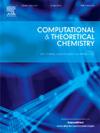评价XB23N24, (X = B, Al, Ga)纳米笼对吉西他滨抗癌药物的传递和传感性能
IF 3
3区 化学
Q3 CHEMISTRY, PHYSICAL
引用次数: 0
摘要
采用密度泛函理论(DFT)评价BN纳米笼作为GEM纳米传感器和药物递送载体的作用,评价了原始B24N24纳米笼及其掺杂Al和ga的纳米笼与吉西他滨(GEM)药物的相互作用。在纳米笼上,GEM既可以吸附在硼原子上,也可以吸附在掺杂原子上。基于区域对自然轨道(DLPNO)的单、双、三重激发耦合簇法(CCSD(T))计算表明,裸B24N24和Al、Ga掺杂纳米笼对药物的吸附能分别为- 31.79、- 61.51和- 59.60 kcal mol - 1。金属的掺杂增强了偶极矩,发现配合物比吉西他滨具有更高的溶剂化能,这有助于提高GEM的溶解度和生物利用度。最高已占据分子轨道(HOMO)、最低未占据分子轨道(LUMO)和HOMO-LUMO能隙对掺杂原子敏感,GEM/B24N24配合物的能隙较低,电导率显著提高。非共价相互作用分析表明,GEM中酰胺基团的氢原子与纳米笼形成键,会减少酰胺基团的脱胺作用,从而延长药物的半衰期。计算表明,药物的半衰期可以通过合理选择尝试频率和掺杂金属原子来调节。当GEM吸附在GaB23N24纳米笼上时,发现其紫外可见光谱出现了明显的红移,因此可以作为光传感器。B24N24吸附GEM后的功函数浪涌支持原始纳米笼,该纳米笼可作为功函数(Φ)型电子传感器用于检测GEM。因此,B24N24纳米笼是工作功能型电子传感器和掺杂ga纳米笼作为光传感器和药物载体的有前途的器件。本文章由计算机程序翻译,如有差异,请以英文原文为准。

Evaluating the drug delivery and sensing performance of XB23N24, (X = B, Al, Ga) nanocages for gemcitabine anticancer drug
The interaction of pristine B24N24 nanocages and their Al and Ga-doped nanocages with gemcitabine (GEM) drug was evaluated using density functional theory (DFT) to evaluate BN nanocages for the purpose of GEM nanosensors and drug delivery vehicles. GEM undergoes adsorption on the nanocages either on the boron atom or on the dopant atom. The domain-based local pair natural orbital (DLPNO)-based coupled-cluster method with single, double, and triple excitations (CCSD(T)) based calculations show that the adsorption energy of the drug was −31.79, −61.51, and − 59.60 kcal mol−1 for bare B24N24 and Al and Ga doped nanocages. The doping of metals has enhanced the dipole moment, and the complexes were found to have higher solvation energy than gemcitabine, which helps to improve the solubility and bioavailability of GEM. The highest occupied molecular orbital (HOMO), lowest unoccupied molecular orbital (LUMO) and HOMO-LUMO energy gap were sensitive to the dopant atom, and the low energy gap was found for the GEM/B24N24 complex with a substantial increase in electrical conductivity. Noncovalent interaction analysis shows that the hydrogen atom of the amide group in GEM makes a bond with the nanocage, which would reduce the deamination of the group and thereby increase the half-life of the drug. Calculations indicate that the half-life of the drug can be modulated using the judicious choice of attempted frequency and dopant metal atom. The UV–visible spectra of GaB23N24 nanocage were found to show substantial redshift when GEM is adsorbed on it and could, therefore, be a photosensor. The surge of work function upon the adsorption of GEM on B24N24 supports the pristine nanocage, which could be a work function (Φ) type electronic sensor used to detect GEM. Thus, B24N24 nanocages are promising devices for work function-type electronic sensors and Ga-doped nanocages as photosensors and drug carriers.
求助全文
通过发布文献求助,成功后即可免费获取论文全文。
去求助
来源期刊

Computational and Theoretical Chemistry
CHEMISTRY, PHYSICAL-
CiteScore
4.20
自引率
10.70%
发文量
331
审稿时长
31 days
期刊介绍:
Computational and Theoretical Chemistry publishes high quality, original reports of significance in computational and theoretical chemistry including those that deal with problems of structure, properties, energetics, weak interactions, reaction mechanisms, catalysis, and reaction rates involving atoms, molecules, clusters, surfaces, and bulk matter.
 求助内容:
求助内容: 应助结果提醒方式:
应助结果提醒方式:


